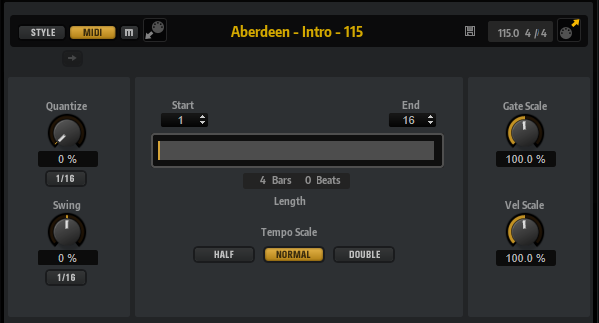MIDI Player
The MIDI Player allows you to load your own MIDI files or one of the included MIDI patterns and set up playback for them.

- Mute Pattern
-
Mutes the current pattern.
- MIDI Import
-
To import MIDI files from your file system or MIDI parts from your host application into the user pattern library, drag them onto the MIDI Import
 field.
field.You can import multiple MIDI files at the same time. The first file is assigned to the selected pad.
- Load MIDI Pattern
-
Allows you to load a MIDI pattern.
NotePattern pads always contain the MIDI data and do not reference the original MIDI files.
You can also load a pattern by dragging it from the Load panel onto the Load MIDI Pattern field. If you drag a style file onto the field, the Agent page automatically switches to the Style Player.
- Save MIDI Pattern
-
Allows you to save the current MIDI pattern as user pattern.
- Original Tempo/Time Signature
-
Displays the original tempo and time signature as saved in the MIDI file.
- MIDI Export
-
To export a pattern, click the MIDI Export
 field and drag it onto a MIDI track in your host application. You can also drag the pattern to other locations and applications that support MIDI files.
field and drag it onto a MIDI track in your host application. You can also drag the pattern to other locations and applications that support MIDI files. - Quantize Amount
-
This parameter defines how much of the quantization grid is applied. A value of 100 % means the MIDI note events play back only at the specified quantize note value. Smaller values move the notes only partially towards the next quantize note value. With a value of 0 %, no quantization is applied.
- Quantize Grid
-
This parameter allows you to set up a quantization grid, in fractions of beats. You can also specify dotted and triplet values.
- Swing Factor
-
Allows you to shift the timing of notes on even numbered beats to give the pattern a swing feeling. Negative values shift the timing backward, and the notes are played earlier. Positive values shift the timing forward, and the notes are played later.
- Swing Grid
-
Determines the grid for applying Swing. For example, to shift the timing of every 16th note in a pattern, set this to 1/16.
- Start
-
Specifies the beat from which the pattern starts to play.
- End
-
Specifies the end of the pattern. Initially, this parameter is set to the original length of the MIDI pattern.
This value is limited to the length of the pattern.
- Effective Pattern Length
-
You can use the range slider below the Start and End parameters to adjust the range of the pattern loop. To change one of the values, drag the left or right edge of the slider.
- Gate Scale
-
Allows you to shorten or lengthen the notes of the pattern. At a value of 100 %, the notes play with their original gate length.
NoteGate Scale has no effect on samples that are played in One Shot mode. They always sound until the end.
- Velocity Scale
-
Raises or lowers the note-on velocities of the pattern. At a value of 100 %, the notes are played with their original velocity.
- Tempo Scale
-
Defines the speed at which the pattern is running. You can choose between half, normal, and double speed.
MIDI Import/Export and Alternative Trigger Note Mappings
If you are working with alternative trigger note mappings, this is taken into account and the MIDI pattern is adapted automatically on import/export. This is important if you are recording MIDI with a hardware drum controller and you want to import MIDI parts from the host application or export patterns from Groove Agent SE to the host application during that process.
If you recorded the MIDI file with the standard trigger note mapping, deactivate Use Hardware Controller Mapping in the pad section.